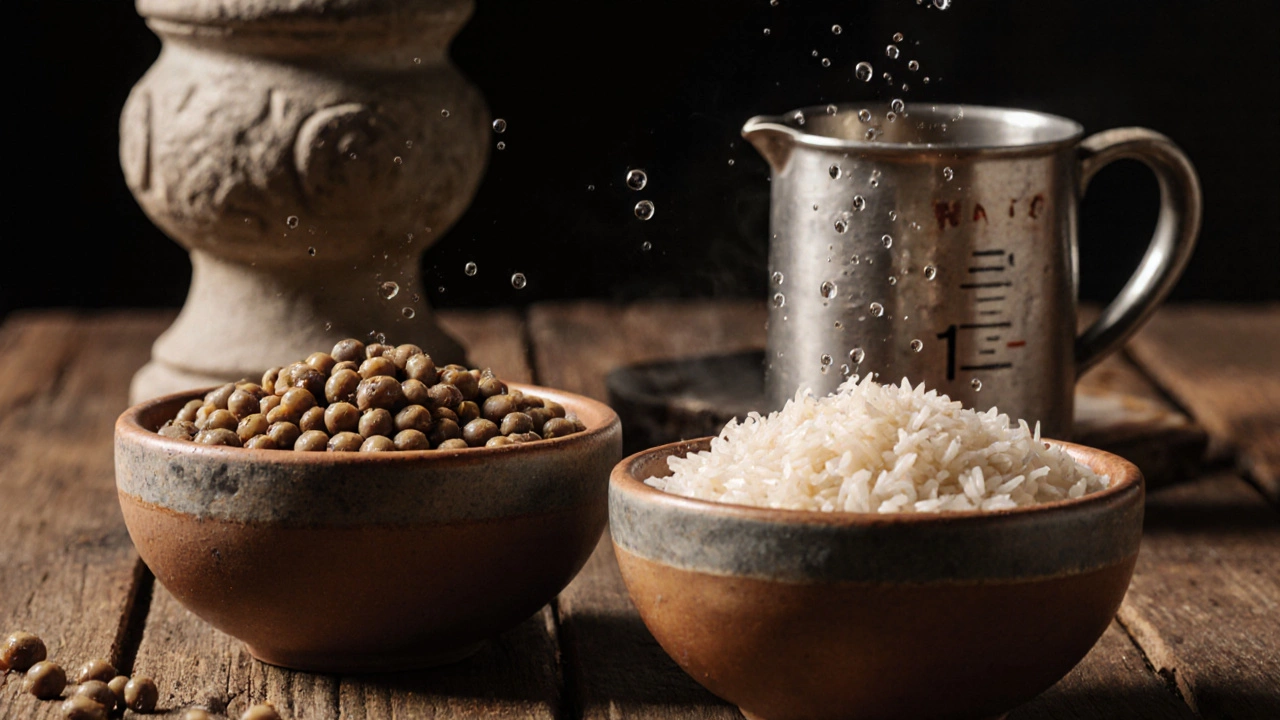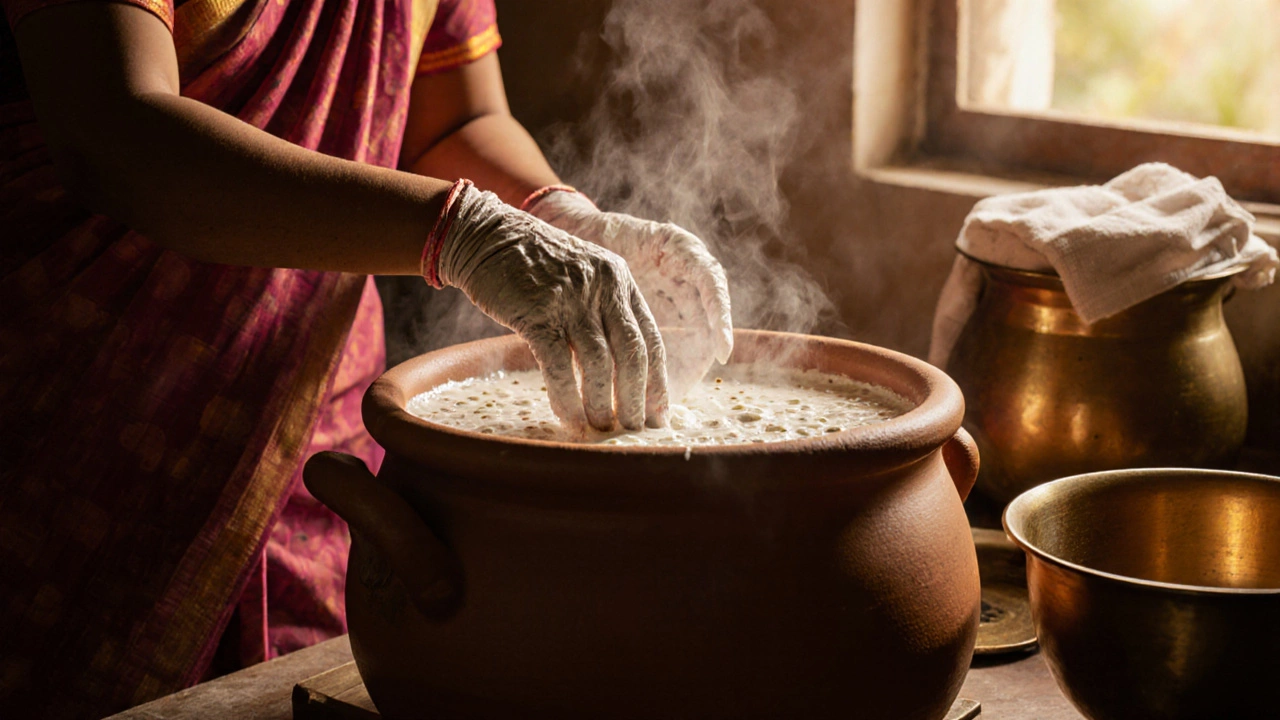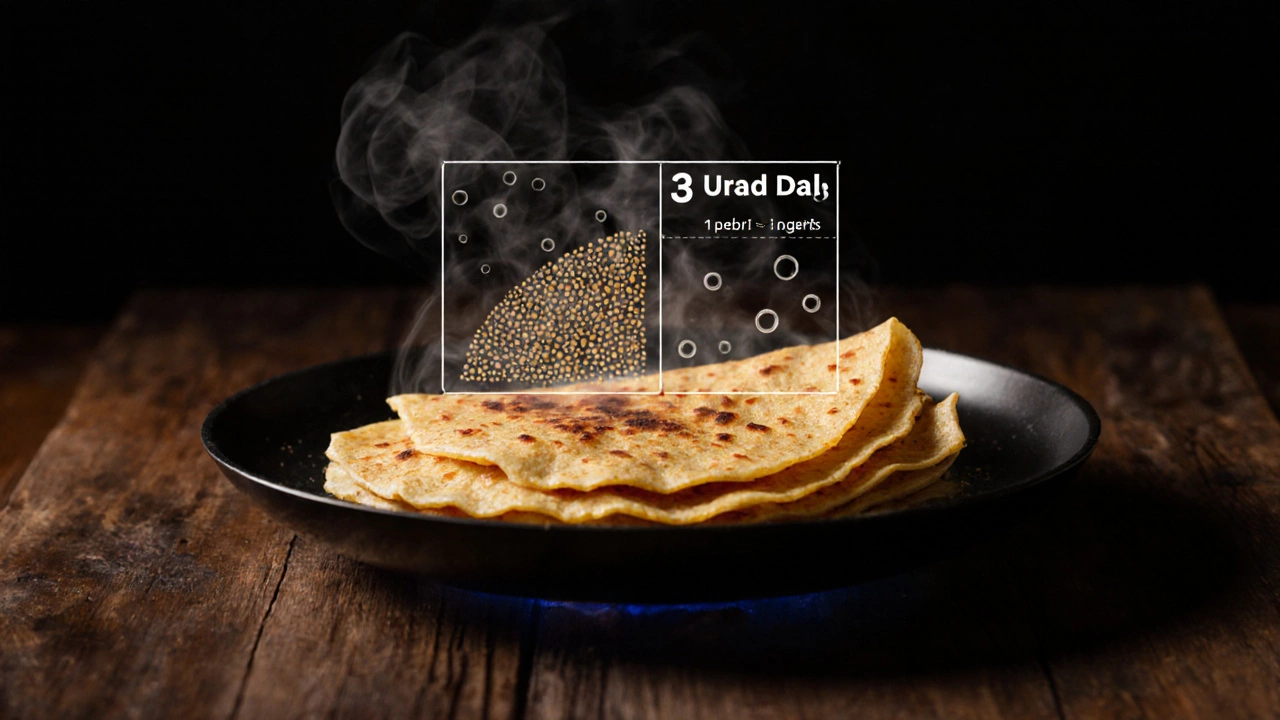What Is the Ratio of Urad Dal to Rice for Perfect Dosa Batter?
20 November 2025

Dosa Batter Ratio Calculator
Why 1:3 Ratio Matters
Using the correct ratio of 1 part urad dal to 3 parts rice creates perfectly fermented, fluffy, and crisp dosas. Too much rice prevents proper fermentation, while too much urad dal makes dosas sticky.
Your Perfect Batter
Enter your rice amount to see the required urad dal
Pro Tip: Always use parboiled short-grain rice (idli/ponni rice) for best results. Avoid long-grain varieties like basmati.
- Soak rice and urad dal separately for 6-8 hours
- Grind urad dal to a fluffy paste
- Keep batter in warm place (28-32°C) for 8-12 hours
- Always use whole black urad dal with skin
Getting the right urad dal to rice ratio is the single most important step in making soft, fluffy, and crisp dosas at home. Too much rice, and your batter won’t ferment well. Too much urad dal, and your dosas turn sticky or rubbery. The sweet spot? A 1:3 ratio of urad dal to rice. That’s one part soaked urad dal to three parts soaked raw rice. This isn’t just a suggestion-it’s the standard used by street vendors in Chennai and home cooks across Tamil Nadu for generations.
Why the 1:3 Ratio Works
The science behind this ratio is simple. Urad dal contains more protein and less starch than rice. When soaked and ground, it creates a thick, airy foam that traps air bubbles during fermentation. Rice provides the structure and bulk. Together, they create a batter that rises evenly, holds its shape, and crisps up perfectly on the griddle.
Try using a 1:4 ratio-more rice-and you’ll notice your dosas don’t puff up. They stay flat and chewy. Go with 1:2-more urad dal-and the batter becomes too sticky, the dosas tear easily, and they don’t crisp at the edges. The 1:3 balance gives you the lift, the texture, and the flavor all in one.
Which Rice and Urad Dal to Use
Not all rice or urad dal is the same. For dosa batter, you need short-grain parboiled rice, like idli rice or ponni rice. These varieties have just the right starch content to ferment well without turning gummy. Avoid long-grain basmati or jasmine rice-they’re too fragrant and too dry. They don’t break down properly during grinding, and your batter ends up grainy.
For urad dal, use whole black urad dal with the skin on. Don’t use split urad dal (dalia) or peeled urad dal. The skin is where the natural yeasts and bacteria live that help fermentation. It’s also what gives the batter its signature froth. If you use peeled urad dal, your batter might ferment, but it won’t rise properly. You’ll get flat, dense dosas.
How to Soak and Grind the Ingredients
Soaking is non-negotiable. Soak the rice and urad dal separately for at least 6 hours, or overnight. Use cold, clean water. Don’t soak them together-rice takes longer to soften than urad dal. If you soak them together, the dal gets mushy before the rice is ready.
Drain the water before grinding. Add just enough fresh water to help the grinder turn. For the urad dal, grind slowly until it’s light, fluffy, and forms a thick paste that holds a peak when you lift the spatula. This can take 10-15 minutes. For the rice, grind it to a slightly coarser texture than the dal. It should feel gritty, not smooth.
Once both are ground, mix them together gently. Don’t beat the batter. Just fold it with a spoon. Add salt at this stage-about 1 teaspoon per cup of rice. Salt helps control fermentation and improves flavor.

Fermentation: The Secret Ingredient
Fermentation isn’t optional. It’s what turns a thick paste into airy, bubbly dosa batter. Leave the batter in a warm spot-around 28-32°C-for 8 to 12 hours. In Auckland’s cooler climate, you might need to place the bowl near a warm oven or wrap it in a towel and keep it on top of the fridge.
Look for signs of fermentation: the batter should double in volume, smell slightly sour like yogurt, and have lots of bubbles on top. If it doesn’t rise after 12 hours, it’s likely too cold. Try adding a pinch of fenugreek seeds (1/4 tsp) to the urad dal before soaking. Fenugreek boosts natural fermentation and gives dosas a subtle aroma.
Common Mistakes and How to Fix Them
Many people mess up dosa batter because they skip the basics. Here are the top mistakes and how to avoid them:
- Using pre-ground batter - Store-bought batter often contains preservatives and doesn’t ferment properly. It’s also too thin. Always grind fresh.
- Adding too much water while grinding - This makes the batter runny. Thick batter = fluffy dosas. Thin batter = crispy but flat dosas.
- Not covering the batter - Exposure to air dries out the surface and kills the yeast. Always cover with a lid or damp cloth.
- Stirring the batter before cooking - Stirring pops the air bubbles. Gently pour or ladle it onto the pan.
- Using a cold griddle - Your tawa must be hot. Test it by sprinkling water-it should sizzle and evaporate instantly.
Adjusting for Humidity and Altitude
If you live in a humid place like Auckland, fermentation happens faster. You might only need 6-8 hours. In dry climates, it can take up to 16 hours. If you’re at high altitude, fermentation slows down. Add an extra 1/2 teaspoon of fenugreek seeds and let it sit longer.
During winter, keep the batter near a radiator or use a proofing box. Some people even place the bowl in a microwave with a cup of hot water to create a warm microclimate.

What to Do If Your Batter Doesn’t Ferment
If your batter doesn’t rise after 16 hours, don’t throw it out. Add 1/4 teaspoon of baking soda and mix gently. This won’t give you the same flavor as natural fermentation, but it’ll make the dosas puff up. You can also mix in 2 tablespoons of leftover fermented batter from a previous batch. It’s like a sourdough starter-your own living culture.
Pro tip: Save 1/4 cup of your fermented batter in the fridge. Use it as a starter for your next batch. It speeds up fermentation and adds depth of flavor. This is how traditional families keep their dosa batter going for years.
How Much Batter Do You Need?
One cup of uncooked rice and one-third cup of urad dal makes enough batter for 8-10 medium dosas. That’s a good starting point for a family breakfast. If you’re cooking for a crowd, scale up using the same 1:3 ratio. Don’t double the recipe in one big batch-grind in two smaller batches. Overloading the grinder heats the batter and kills the good bacteria.
Why This Ratio Is Trusted Across India
Every region in South India has its own twist-some add poha or chana dal, others use raw rice instead of parboiled. But the core 1:3 ratio stays the same. Even at famous dosa joints in Bengaluru or Madurai, they measure by volume, not weight. Why? Because it’s reliable. It works whether you’re using a stone grinder or a high-speed blender.
Try this ratio once, and you’ll never go back to the 1:4 or 1:2 versions. The difference isn’t subtle. It’s the difference between a crisp, golden dosa that cracks when you fold it, and a floppy, lifeless pancake.
Can I use brown rice instead of white rice for dosa batter?
Brown rice isn’t ideal for traditional dosa batter. It has more fiber and oil, which slows down fermentation and makes the batter dense. If you want a healthier version, use parboiled brown rice-but expect longer soaking (10-12 hours) and slower fermentation. The texture will be chewier, not crispy.
Can I use a blender instead of a grinder?
Yes, but you need to be careful. Blenders generate more heat, which can kill the natural yeasts. Grind in short bursts, pause to let the motor cool, and use less water. The batter may not get as airy as with a stone grinder, but it still works. Add a pinch of fenugreek to help fermentation.
How long can I store dosa batter in the fridge?
Well-fermented dosa batter lasts up to 5 days in the fridge. Always cover it tightly. If it starts to smell overly sour or develops mold, toss it. Before using, let it sit at room temperature for 30 minutes. If it’s too thick, stir in a tablespoon of water.
Why do my dosas stick to the pan?
Sticking usually means your tawa isn’t hot enough or you didn’t oil it properly. Heat the pan until a drop of water dances on it. Then wipe it lightly with a paper towel dipped in oil. Don’t pour oil into the batter-only grease the pan. Also, don’t pour the batter too early. Wait until the batter spreads easily without dragging.
Can I make dosa batter without urad dal?
No-not if you want authentic dosas. Urad dal provides the lift and texture. Without it, you’ll get something closer to a rice crepe, not a dosa. Some gluten-free recipes use chickpea flour or buckwheat, but they’re not traditional and won’t taste the same.
If you’re serious about making perfect dosas, stick to the 1:3 urad dal to rice ratio. Measure by volume, soak separately, grind slowly, and let it ferment in warmth. That’s all it takes. No fancy tools, no complicated steps. Just patience and the right proportions.